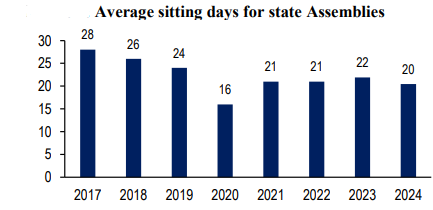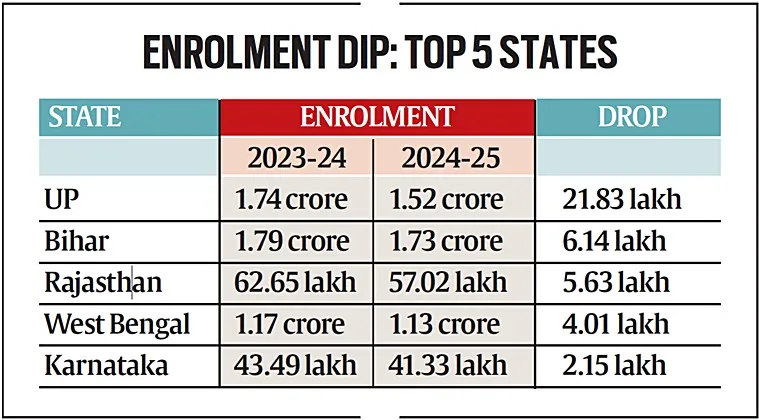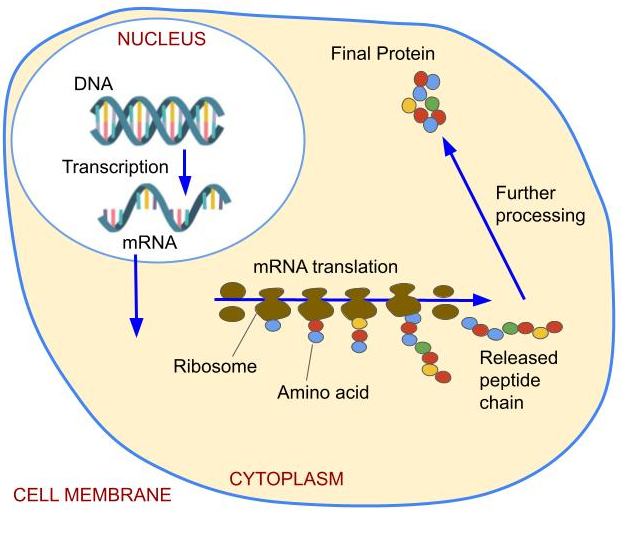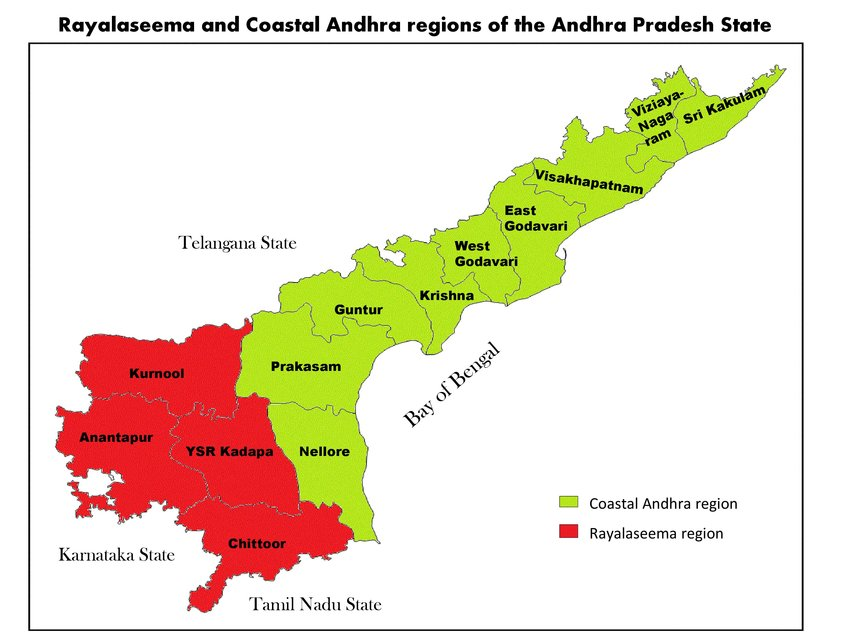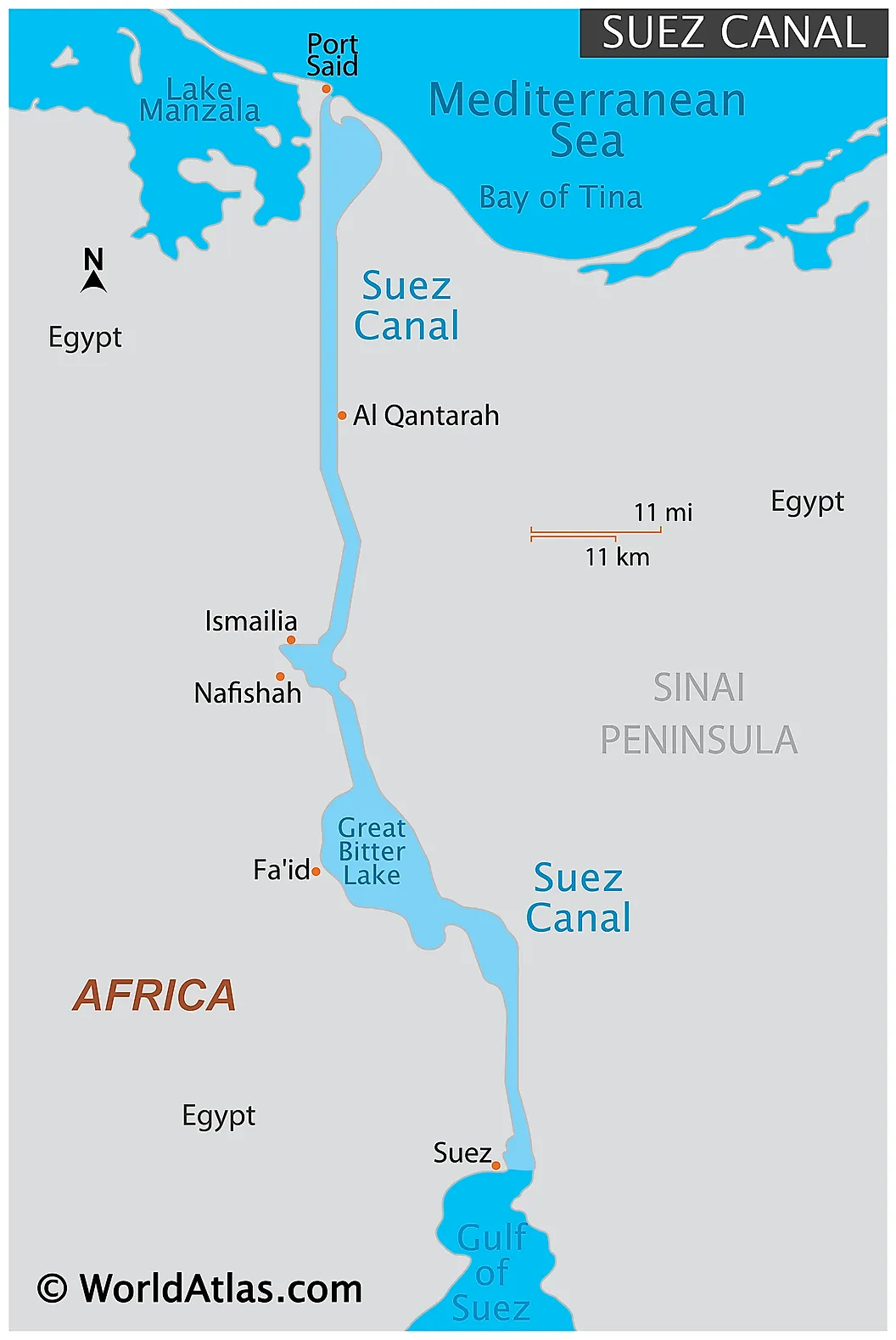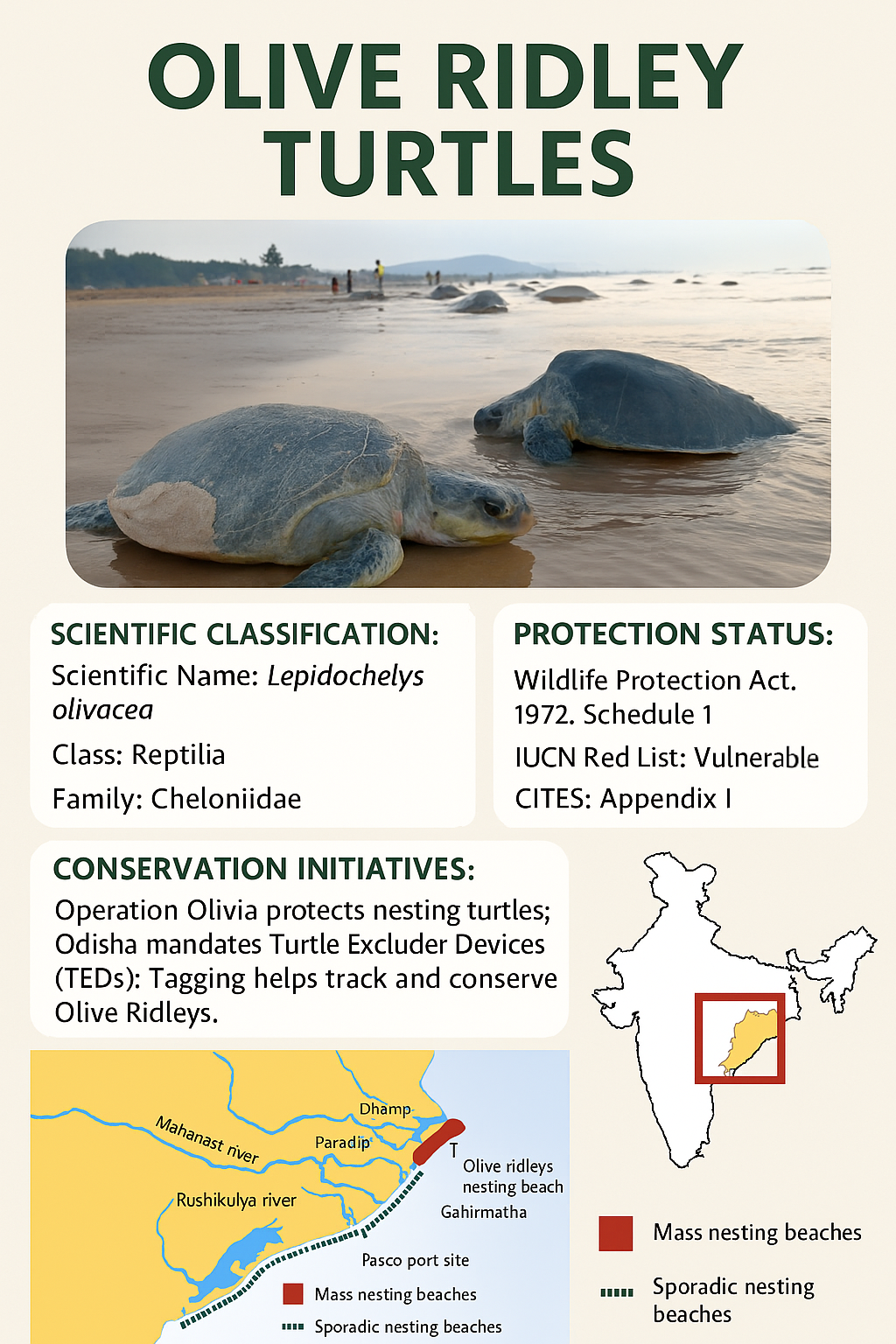Indian Polity
Annual Review of State Laws 2024
For Prelims: State Legislative Assemblies, Article 178, Deputy Speaker , Question Hour, Sessions of State Legislature
For Mains: Decline in the functioning of State Legislative Assemblies in India, Reforms to improve productivity and deliberation in state legislatures
Why in News?
A report titled Annual Review of State Laws 2024 by PRS Legislative Research, a non-partisan think tank, reveals that India’s state legislative assemblies are functioning with alarmingly low productivity.
What is the Status of Legislative Assemblies in India?
- Low Number of Sitting Days: In 2024, state legislative assemblies met for an average of only 20 days, down from 28 days in 2017 and 16 days in 2020 (pandemic year).
- Some states have minimum sitting day requirements under their Rules of Procedure. None of the states met their own targets in any year from 2017 to 2024.
- Variation Across States: Odisha (42 days) and Kerala (38 days) had the highest sittings in 2024. Larger states like Uttar Pradesh and Madhya Pradesh met for just 16 days.
- Vacancy in the Deputy Speaker's Post: Despite Article 178 of the Constitution mandating the election of a Deputy Speaker in every State Legislative Assembly, 8 state assemblies currently do not have one. Notably, Jharkhand has been without a Deputy Speaker for over 20 years.
- The Lok Sabha also lacks a Deputy Speaker from June 2019.
- Bills Passed Without Deliberation: States passed an average of 17 bills in 2024.
- Over 51% of bills were passed on the same day they were introduced, often without debate. The average duration of each sitting was only 5 hours.
- The quality of legislative debate is deteriorating, with most bills receiving minimal discussion. This trend of rushed law-making reflects a weakening of deliberative democracy.
- Focus Areas of Legislation: About half of the laws were related to education, finance, and local governance.
- Uttarakhand became the first state to pass a Uniform Civil Code, while West Bengal introduced the Aparajita Act, mandating stricter penalties for rape.
- Madhya Pradesh brought in legislation to regulate private school fees, and
- Maharashtra granted 10% reservation to Marathas in education and government jobs.
What Key Facts About State Legislature in India?
- Constitutional Provisions: The structure, powers, and functioning of State Legislatures are governed by Part VI of the Constitution, from Articles 168 to 212.
- These articles lay down the organization, composition, duration, powers, and procedures of state legislative bodies.
- Composition: Article 168 of the Constitution of India provides for the constitution of State Legislatures.
- There are two types of state legislatures: unicameral and bicameral.
- A unicameral legislature comprises the Governor and the Legislative Assembly (Vidhan Sabha), which is the more common structure in most states. In contrast, a bicameral legislature includes the Governor, the Legislative Assembly, and the Legislative Council (Vidhan Parishad).
- There are two types of state legislatures: unicameral and bicameral.
- Sessions of State Legislature:
- Summoning: The Governor summons the State Legislature to meet from time to time. The maximum gap between two sessions cannot exceed six months. A session consists of multiple sittings.
- Article 174 mandates state legislatures to meet at least twice a year, with no more than six months between sessions.
- Adjournment: It is the temporary suspension of House proceedings for hours, days, or weeks.
- Prorogation: After the session ends, the Governor officially ends the session by issuing a notice. This is called prorogation, it can be issued even when the House is in session.
- Adjournment ends a meeting, but prorogation ends the session.
- Dissolution: Applies only to the Legislative Assembly, not the Legislative Council (permanent house).
- Dissolution ends the full term of the Assembly, leading to fresh elections.
- Quorum: It is the minimum number of members needed to start a meeting. It is either 10 members or 1/10th of total members, whichever is greater.
- If quorum is not met, the House is adjourned or suspended by the Presiding Officer.
- Voting in the House: Decisions are by majority of members present and voting. The Presiding Officer votes only in the case of a tie (casting vote).
- Special majority is required only in specified cases (e.g., removal of Speaker/Chairman).
- Language in State Legislature: Business is conducted in the official state language, Hindi, or English. Members can speak in their mother tongue with permission.
- States may discontinue English after 15 years (most states), 25 years (Himachal Pradesh, Manipur, Meghalaya, Tripura), and 40 years (Arunachal Pradesh, Goa, Mizoram)
- Rights of Ministers and Advocate General: Ministers and the Advocate General can speak and take part in discussions in either House or its committees, even if not members. However, they cannot vote unless they are elected members.
- Summoning: The Governor summons the State Legislature to meet from time to time. The maximum gap between two sessions cannot exceed six months. A session consists of multiple sittings.
What are the Implications of Low Productivity of State Legislative Assemblies?
- Weakening of Democratic Deliberation: Legislative assemblies are meant to deliberate on laws, budgets, and public issues, but low productivity undermines this role.
- In 2021, Nearly 44% of the 583 Bills tabled in state Assemblies were passed within a day after they were introduced, leaving no scope for informed debate, resulting in laws that lack depth, foresight, and public engagement.
- Decline in Legislative Oversight: Assemblies often fail to hold the executive accountable through instruments like Question Hour, motions, and debates.
- Fewer sittings mean reduced scrutiny of public expenditure, departmental performance, and policy impact. This undermines accountability and transparency, key pillars of democratic governance.
- Poor Quality of Legislation: In most states, bills are passed without referral to the Public Accounts Committee (PAC). Ad hoc Select Committees are rare; hence, sectoral expertise and stakeholder consultations are missing.
- Consequently, laws are often poorly drafted, hastily passed, and vulnerable to legal and implementation challenges.
- Delayed or Arbitrary Governance: Many Bills require the Governor’s assent to become law. However delays in granting assent by Governors are frequent and often unexplained. This raises serious concerns about arbitrary governance and a lack of accountability in the legislative process.
- Additionally, over-reliance on ordinances (Kerala issued 144 in 2021) circumvents legislative scrutiny.
- Overlooking Local Aspirations: State legislatures' inaction on key areas like education, health, land, agriculture, and policing delays essential reforms, depriving people of timely grassroots solutions.
How can the Productivity of State Legislative Assemblies be Enhanced??
- Fix Minimum Sitting Days: The National Commission to Review the Working of the Constitution (NCRWC) has recommended mandatory minimum sittings for State Assemblies, at least 50 days a year for those with fewer than 70 members, and 90 days for those with more than 70.
- Amending Article 174 to mandate minimum sitting days for state legislatures would curb long adjournments and ensure regular legislative functioning.
- Strengthen Committee System: Institutionalising ad hoc Select Committees and Standing Committees, and enabling expert and stakeholder engagement, will lead to more informed, evidence-based legislation, enhancing productivity by reducing policy gaps, improving scrutiny, and ensuring faster, more effective implementation.
- Promote E-Governance and Transparency: Implement the National e-Vidhan Application (NeVA) to digitise all legislative processes. Nagaland has become the first state to fully adopt NeVA.
- Ensure live telecast of proceedings to boost citizen awareness and participation.
- Review of Laws by the Legislature: Laws must evolve with changing societal contexts, making regular reviews essential to ensure their continued relevance and effectiveness.
- For instance, the Information Technology Act, 2000 underwent amendments to address emerging cybercrimes that were not envisaged earlier.
- Periodic scrutiny helps correct hastily drafted or politically motivated laws, promoting legal efficacy and public interest.
- Legislative reviews also help identify unintended consequences, and promote accountability by ensuring laws align with their intended purpose and democratic values.
- RTI and Bilingual Accessibility: Ensure assembly websites are regularly updated with debates, Bills, and reports. Content should be published both in vernacular languages and in English to ensure wider access and better understanding.
|
Drishti Mains Question: State legislatures are witnessing a steady decline in productivity and oversight. Examine the causes and suggest institutional reforms to address this challenge. |
UPSC Civil Services Examination, Previous Year Questions (PYQ)
Prelims
Q. Which of the following are the discretionary powers given to the Governor of a State? (2014)
- Sending a report to the President of India for imposing the President’s rule
- Appointing the Ministers
- Reserving certain bills passed by the State Legislature for consideration of the President of India
- Making the rules to conduct the business of the State Government
Select the correct answer using the code given below:
(a) 1 and 2 only
(b) 1 and 3 only
(c) 2, 3 and 4 only
(d) 1, 2, 3 and 4
Ans: (b)
Mains
Q. Whether the Supreme Court Judgment (July 2018) can settle the political tussle between the Lt. Governor and elected government of Delhi? Examine. (2018)
Q. Discuss the essential conditions for exercise of the legislative powers by the Governor. Discuss the legality of re-promulgation of ordinances by the Governor without placing them before the Legislature. (2022)


Governance
Tackling Online Abuse
For Prelims: Cyber Harassment, Bharatiya Nyaya Sanhita (BNS), 2023, Information Technology (IT) Act, 2000, High Court, Supreme Court, Digital Personal Data Protection (DPDP) Act, 2023, Deepfake, Digital Literacy Program.
For Mains: Online abuse and its forms, Challenges and remedial steps to tackle online abuse in India.
Why in News?
Following the Pahalgam terror attack, a peace appeal by a victim resulted in her severe trolling. Similarly, India’s Foreign Secretary faced abusive remarks after announcing India-Pakistan ceasefire.
- It revealed India’s growing crisis of cyber harassment and weak regulation highlighting the need for legal reform, platform accountability, and victim protection.
What is Online Abuse?
- About: Online abuse (cyber abuse, digital abuse, or internet harassment) refers to any form of harmful, threatening, or demeaning behavior that occurs through digital platforms.
- It can be directed at individuals, groups, or entire communities and can take many forms, from verbal attacks and harassment to the non-consensual sharing of private information or images.
- Types:
- Cyberbullying: It is the use of digital platforms to harass, threaten, or humiliate someone repeatedly, causing emotional harm.
- Cyberstalking: It is persistent, unwanted online monitoring and harassment that causes fear, involving repeated messages, tracking activity, or using spyware and fake accounts.
- Trolling: Trolling is deliberately posting offensive or provocative messages online to upset people or disrupt conversations.
- Doxxing: Doxxing, short for “dropping dox” (documents), is the unauthorized online sharing of private information, like addresses or phone numbers, often to harass or threaten victims.
- Revenge Porn: It is sharing or threatening to share intimate images without consent, violating privacy and often used for blackmail or humiliation.
- Catfishing: It is creating a fake online identity to deceive others, often for emotional, financial, or malicious purposes.
- Status of Cyberbullying in India: India has the highest cyberbullying rate globally, with over 85% of children reported it.
- About 46% reported bullying strangers (vs. 17% globally) and 48% bullied someone they know (vs. 21%).
- Top forms include spreading false rumours (39%), exclusion from chats/groups (35%), and name-calling (34%).
- Legal Provisions to Tackle Online Abuse:
- Bharatiya Nyaya Sanhita (BNS), 2023:
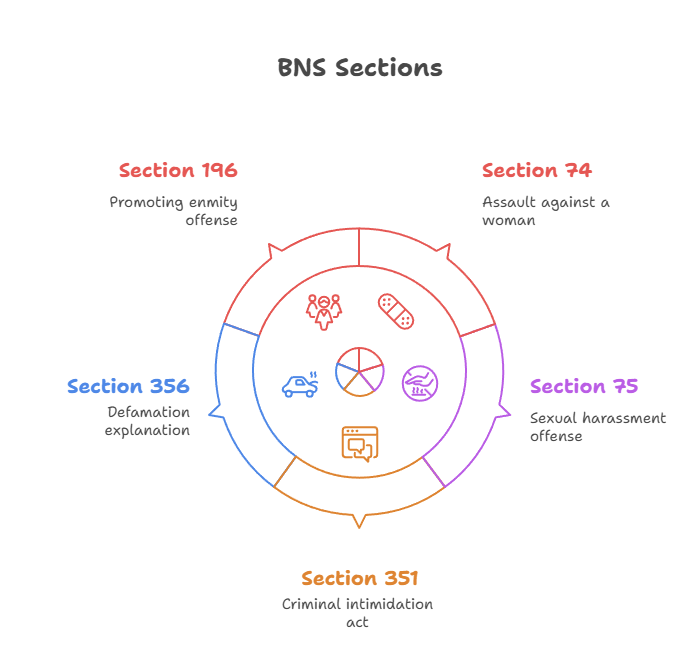
- Information Technology (IT) Act, 2000:
- Section 66C: Identity theft
- Section 66D: Impersonation fraud
- Section 67: Publishing or transmitting obscene material electronically.
- Digital Personal Data Protection Act (DPDP), 2023: DPDP provides for penalties for failing to prevent data breaches leading to harassment
- IT (Intermediary Guidelines & Digital Media Ethics Code) Rules, 2021: Social media platforms must disclose the first originator of content for investigations into offences like rape, death threats, sexually explicit material, and content threatening state harmony or international relations.
- Bharatiya Nyaya Sanhita (BNS), 2023:
- Judicial Stand:
- Shaviya Sharma vs Squint Neon & Ors Case, 2024: The Delhi High Court ordered removal of tweets exposing a woman’s personal details, recognizing doxxing’s serious privacy and safety risks despite lacking specific legal status.
- Shreya Singhal v. Union of India Case, 2015: The Supreme Court struck down Section 66A of the IT Act, which criminalized “offensive” online speech, as unconstitutional—protecting free speech while emphasizing that reasonable restrictions must be narrowly defined.
- KS Puttaswamy v. Union of India Case, 2017: The Supreme Court declared privacy a fundamental right (article 21), laying the foundation to protect personal data and prevent unauthorized online disclosure or doxxing.
What are the Challenges in Tackling Online Abuse in India?
- No Dedicated Law: India currently lacks a specific law that directly addresses online hate speech and trolling comprehensively.
- Existing laws don’t cover ongoing online abuse unless it’s obscene, threatening, or fraudulent.
- Stalking laws are gender-specific (limited to men targeting women) and target individual intent, overlooking mass online harassment.
- Content Moderation Challenges: Social media companies are taking significantly fewer content screening and proactive measures to address hate speech in India compared to the US and EU.
- Platforms like Telegram are facing legal action for permitting criminal activity, while profit motives have weakened moderation, allowing hate speech to spread.
- Ambiguity over “Publicly Available Data”: The Digital Personal Data Protection (DPDP) Act, 2023 exempts “publicly available” personal data but lacks a clear definition, creating ambiguity.
- This gap may enable cybercrimes like doxxing, as fragmented data from various platforms can be easily combined for harassment or intimidation.
- Enforcement Gaps: There is lax implementation of the IT Rules in India, leading to weak enforcement of digital safety and accountability standards.
- Victims, especially of gendered abuse, face disbelief and victim-blaming, discouraging legal recourse.
What can be Remedial Steps to Tackle Online Abuse in India?
- Legal & Policy Reforms: A dedicated cyber harassment law should be enacted to clearly define and criminalize doxxing, deepfake abuse, and coordinated trolling.
- Amend the IT Act and BNS to clearly define obscene, threatening, and hate speech for clarity and to prevent misuse.
- Strengthening Enforcement: To effectively combat cybercrime, it is essential to establish specialized cyber cells and train police in areas like IP tracking and identifying anonymous accounts.
- A leading example is Kerala’s Cyberdome, which brings together police, ethical hackers, academia, and tech firms to advance cybercrime detection, digital forensics, and AI-based surveillance.
- Implement robust whistleblower protections to safeguard victims reporting online abuse from retaliation and counter-harassment.
- Tech & Platform-Level Solutions: Leverage AI-powered detection and machine learning to flag hate speech, deepfakes, and abusive trends, enabling real-time moderation of violent and sexual content.
- Implement user verification systems to penalize fake profiles and bot-driven harassment.
- Public Awareness: Implement digital literacy programs in schools and colleges to teach responsible social media use and to debunk fake news, hate narratives, and conspiracy theories.
- Launch anti-trolling campaigns promoting positive behavior and countering communal and sexist abuse through influencers and media.
- Corporate Responsibility: Platforms should adopt ethical monetization policies by stopping algorithmic amplification of hate and demonetizing abusive content creators.
- Social media firms should enforce strict monitoring of online abuse, similar to the measures implemented in the US and Europe.
Conclusion
Stopping online abuse requires strong laws, better enforcement, tech innovation, and societal change. While free speech must be protected, accountability for organized harassment, hate speech, and privacy violations is non-negotiable. A balanced approach—protecting free speech while safeguarding victims—is essential to combat cyberbullying, doxxing, and hate speech in the digital age.
|
Drishti Mains Question: Analyze the need for dedicated legislation to tackle cyber harassment and online trolling in India. |
UPSC Civil Services Examination, Previous Year Question (PYQ)
Prelims
Q. In India, under cyber insurance for individuals, which of the following benefits are generally covered, in addition to payment for the loss of funds and other benefits?
- Cost of restoration of the computer system in case of malware disrupting access to one’s computer
- Cost of a new computer if some miscreant wilfully damages it, if proved so
- Cost of hiring a specialized consultant to minimize the loss in case of cyber extortion
- Cost of defence in the Court of Law if any third party files a suit
Select the correct answer using the code given below:
(a) 1, 2 and 4 only
(b) 1, 3 and 4 only
(c) 2 and 3 only
(d) 1, 2, 3 and 4
Ans: (b)
Q. In India, it is legally mandatory for which of the following to report on cyber security incidents? (2017)
- Service providers
- Data centres
- Body corporate
Select the correct answer using the code given below:
(a) 1 only
(b) 1 and 2 only
(c) 3 only
(d) 1, 2 and 3
Ans: (d)
Mains
Q. What are the different elements of cyber security ? Keeping in view the challenges in cyber security, examine the extent to which India has successfully developed a comprehensive National Cyber Security Strategy. (2022)


Important Facts For Prelims
Enrolment Drop in Government Schools and PM-POSHAN
Why in News?
The Ministry of Education (MoE) convened a discussion with States and UTs to review the performance, planning, and budget of the Pradhan Mantri Poshan Shakti Nirman (PM-POSHAN) scheme, revealing a decline in government school enrolment in 23 States.
What are the Trends in Declining Government School Enrolment?
- Decline in School Enrolment: The Ministry of Education revealed a significant enrolment drop in 23 States and UTs for 2024–25, with some seeing declines of over 1 lakh students.
- It is led by Uttar Pradesh (21.83 lakh), Bihar (6.14 lakh), Rajasthan (5.63 lakh) and West Bengal (4.01 lakh).
- Factors Behind Enrolment Decline:
- Change in Data Collection Methodology: The transition from school-wise (total numbers) to student-wise reporting (name, address, parents’ names and Aadhaar details) likely eliminated outdated records and false entries, such as “ghost” students not actually attending school.
- Shift to Private School: Several States suggest that post-Covid years have seen a shift in enrolment from government to private schools, reversing trends observed during the pandemic.
What is the PM-POSHAN Scheme?
- About: PM-POSHAN is a centrally sponsored scheme for providing one hot cooked meal to students up to Class 8 Government and Government-aided schools.
- Launched for an initial five-year period (2021–22 to 2025–26), it replaced the earlier midday meal scheme (MDM).
- Launched in 1995, the MDM Scheme is the world’s largest school meal programme, aimed at universalizing primary education.
- Launched for an initial five-year period (2021–22 to 2025–26), it replaced the earlier midday meal scheme (MDM).
- Cost Sharing: Its cost is shared by the Centre and States on a 60:40 basis, with the Centre supplying foodgrains.
- Entitlements: Primary (class 1-5) and upper primary (class 6-8) students receive 100g and 150g of food grains daily, ensuring 700 calories.
- It also provides extra nutrition (e.g, milk or eggs) for children in aspirational districts and areas with high anemia rates.
- Key Provisions:
- Nutritional Gardens: It promotes school nutritional gardens to provide students with additional micro-nutrients.
- Tithi Bhojan: The Tithi Bhojan program, where communities provide special food to children on special occasions like festivals, is being widely promoted.
- Nutrition Expert: Each school will appoint a nutrition expert to monitor Body Mass Index (BMI), weight, and haemoglobin levels.
- Social Audit: Social audits are now mandatory in all schools to assess scheme implementation, with college students enlisted for local monitoring.
- Vocal for Atmanirbhar Bharat: It encourages involvement of Farmers Producer Organizations (FPOs) and Women Self Help Groups (SHGs), and promotes locally grown traditional foods to boost local economies
UPSC Civil Services Examination, Previous Year Questions (PYQs)
Prelims
Q. Which of the following are the objectives of ‘National Nutrition Mission’? (2017)
- To create awareness relating to malnutrition among pregnant women and lactating mothers.
- To reduce the incidence of anaemia among young children, adolescent girls and women.
- To promote the consumption of millets, coarse cereals and unpolished rice.
- To promote the consumption of poultry eggs.
Select the correct answer using the code given below:
(a) 1 and 2 only
(b) 1, 2 and 3 only
(c) 1, 2 and 4 only
(d) 3 and 4 only
Ans: (a)


Important Facts For Prelims
A-to-I mRNA Editing
Why in News?
Researchers from China highlighted the process of A-to-I mRNA editing, especially in the wheat pathogen Fusarium graminearum, revealing its complex role in biology.
What is A-to-I mRNA Editing?
- DNA: DNA (Deoxyribonucleic acid) is the genetic material of organisms and has a double helix structure. It is composed of four nucleotides: adenine (A), thymine (T), cytosine (C), and guanine (G), which pair specifically (A with T, and C with G).
- The sequence of these bases carries the instructions for making proteins and Ribonucleic acid (RNA).
- Messenger RNA (mRNA): It is a type of single-stranded RNA that plays a key role in protein synthesis. It is created from DNA during the process of transcription.
- mRNA acts as a messenger by carrying genetic instructions from the DNA in the cell’s nucleus to the cytoplasm, where proteins are made.
- In the cytoplasm, the cell’s protein-making machinery (mainly ribosomes) reads the mRNA sequence.
- Each set of three bases (called a codon) corresponds to a specific amino acid. These amino acids are then linked together to form proteins, which perform essential functions in the body.
- A-to-I mRNA Editing: It is a biological process where the nucleotide adenosine (A) in messenger RNA (mRNA) is enzymatically converted to inosine (I).
- The editing is performed by enzymes called ADARs (Adenosine Deaminases Acting on RNA).
- Impact on Protein Synthesis: Inosine as result of A-to-I mRNA Editing is read as guanine (G) by ribosomes during translation, potentially altering the amino acid sequence of proteins.
Note: Transcription is the process of making an RNA copy of a gene’s DNA sequence. Translation, in genomics, is the process by which the information encoded in messenger RNA (mRNA) directs the addition of amino acids during protein synthesis.
How Does RNA Editing Compare to DNA Editing?
- RNA Editing: It is the process of correcting mistakes in messenger RNA (mRNA) after it has been synthesized from DNA but before it directs protein production.
- This process allows cells to produce normal, functional proteins despite errors in the mRNA sequence.
- RNA Editing Vs. DNA Editing: RNA editing causes temporary changes to the RNA, unlike DNA editing which permanently alters the genome.
- This temporary nature allows doctors to halt therapy if adverse effects arise, reducing long-term risks.
- RNA editing relies on ADAR enzymes naturally found in the human body, lowering the chance of immune reactions compared to DNA editing tools that use bacterial proteins.
- RNA editing is therefore potentially safer for repeated treatments and for patients with immune sensitivities.
UPSC Civil Services Examination, Previous Year Questions (PYQs)
Q1. With reference to agriculture in India, how can the technique of ‘genome sequencing’, often seen in the news, be used in the immediate future? (2017)
- Genome sequencing can be used to identify genetic markers for disease resistance and drought tolerance in various crop plants.
- This technique helps in reducing the time required to develop new varieties of crop plants.
- It can be used to decipher the host-pathogen relationships in crops.
Select the correct answer using the code given below:
(a) 1 only
(b) 2 and 3 only
(c) 1 and 3 only
(d) 1, 2 and 3
Ans: (d)


Rapid Fire
Suggi Migration
Every summer, thousands of families from Rayalaseema, Andhra Pradesh undertake seasonal migration, locally known as Suggi.
- Causes for Suggi Migration: Agriculture in Rayalaseema is entirely dependent on monsoon rains (June–September). No secondary crop season due to lack of water.
- Tanks and ponds dry up during summer, leaving entire villages without drinking or irrigation water. Failed borewells and lack of irrigation projects worsen the crisis.
- Lack of non-farm jobs compels rural workers to migrate. While Mahatma Gandhi National Rural Employment Guarantee Act (MGNREGA) offers Rs 307/day in Kurnool, delayed payments make it unreliable.
- In contrast, migrant work like chilli harvesting pays around Rs 1,000/day, making it a more attractive option.
- Suggi reflects a rural economy trapped in cycles of drought, underdevelopment, and migration.
- Solutions: Irrigation infrastructure is seen as the key to breaking this cycle of seasonal distress. Experts suggest building a weir (low-head dam) to divert 50 thousand million cubic feet of Krishna water to Rayalaseema
- Rayalaseema: It is a semi-arid zone in southern Andhra Pradesh comprising Anantapur, Chittoor, Kadapa, and Kurnool districts. Rivers like Penna and its tributary, the Papagni flow through the region.
| Read more: Migration: Trends, Challenges, and Solutions |


Rapid Fire
Suez Canal
The Red Sea security crisis, triggered by Houthi attacks on commercial vessels, drastically disrupted shipping traffic through the Suez Canal, leading Egypt’s Suez Canal Authority to offer a discount on transit fees to incentivize the return of cargo ships amid lingering regional risks.
- Suez Canal: The Suez Canal is an artificial sea-level waterway running north–south across Egypt’s Isthmus of Suez. It is a vital international shipping route, connecting the Mediterranean Sea to the Indian Ocean via the city of Suez on the Red Sea.
- Geographically, the canal lies in northeastern Egypt, spanning the Isthmus of Suez.
- It stretches from Port Said in the north to Gulf of Suez in the south, effectively separating the African continent from the Sinai Peninsula, and forms the shortest maritime route between Europe and the Indian and Pacific Oceans.
- Significance: The canal accounts for approximately 12-15% of global trade and nearly 30% of global container traffic before the crisis. It serves as a key passage for 8-9% of global energy flows.
- India and Suez Canal: India relies heavily on the Red Sea route, with nearly 80% of export volumes to Europe transiting the canal.
| Read more: Escalating Threat in Red Sea |


Rapid Fire
Operation Olivia
Indian Coast Guard (ICG)’s annual operation, ‘Operation Olivia’ has achieved major success by protecting over 6.98 lakh Olive Ridley turtles nesting at the Rushikulya river mouth in Odisha.
Operation Olivia:
- It was launched in the early 1980s to protect Olive Ridley turtles during their breeding and nesting season along the Odisha coast.
- It aims to ensure safe nesting grounds for these turtles, by preventing unlawful trawling, particularly at Gahirmatha Beach and nearby coastal area of Odisha.
Olive Ridley Turtles (Lepidochelys olivacea):
- About: It is the smallest sea turtle species in the family Cheloniidae, identified by its olive or grayish-green color and heart-shaped carapace.
- Nesting:They are omnivorous and known for the mass nesting event called arribada, where thousands of females nest together, migrating up to 9,000 km over Pacific, Indian, and Atlantic Oceans.
- Major nesting sites include Gahirmatha, Rushikulya and Devi River mouth in Odisha and the Andaman Islands.
- Threats: It includes bycatch, poaching, habitat loss, plastic pollution, and climate change effects.
- Protection Status: Protected under the Wildlife Protection Act, 1972 (Schedule 1), IUCN Red List (Vulnerable), and CITES (Appendix I).
| Read More: Mass Nesting of Olive Ridley Turtles |


Rapid Fire
e-Zero FIR
The Union Home Minister has launched the e-Zero FIR initiative as a pilot project in Delhi under the Indian Cyber Crime Coordination Centre (I4C) to improve the efficiency of investigating cyber financial frauds, supporting the vision of a Cyber Secure Bharat.
- Zero FIR: An Zero FIR can be filed at any police station, regardless of the jurisdiction, for a cognisable offence and is transferred to the proper jurisdiction for investigation.
- e-Zero FIR is the electronic version of Zero FIR and is enabled under Section 173(1) and 1(ii) of the BNSS.
- Key Features of e-Zero FIR:
- Automatic FIR Registration: Cyber financial fraud complaints above Rs 10 lakh, filed via National Cybercrime Reporting Portal (NCRP) or Helpline 1930, will be automatically converted into Zero FIRs.
- Complainants must visit the concerned police station within 3 days to get the Zero FIR converted into a regular FIR.
- Systems Integration: Combines I4C’s NCRP system, Delhi Police’s e-FIR system, and NCRB’s Crime and Criminal Tracking Network & Systems (CCTNS) into a unified cybercrime reporting and investigation framework.
- Automatic FIR Registration: Cyber financial fraud complaints above Rs 10 lakh, filed via National Cybercrime Reporting Portal (NCRP) or Helpline 1930, will be automatically converted into Zero FIRs.
- FIR (First Information Report): An FIR is the first formal report of a cognizable offence (police can arrest without a warrant and begin investigation without magistrate approval) filed by an individual and recorded by the police.
- It initiates the criminal justice process.
- They are regulated under Section 173 of the BNSS, 2023.
| Read More: FIR and General Diary, Cyber Commandos |



